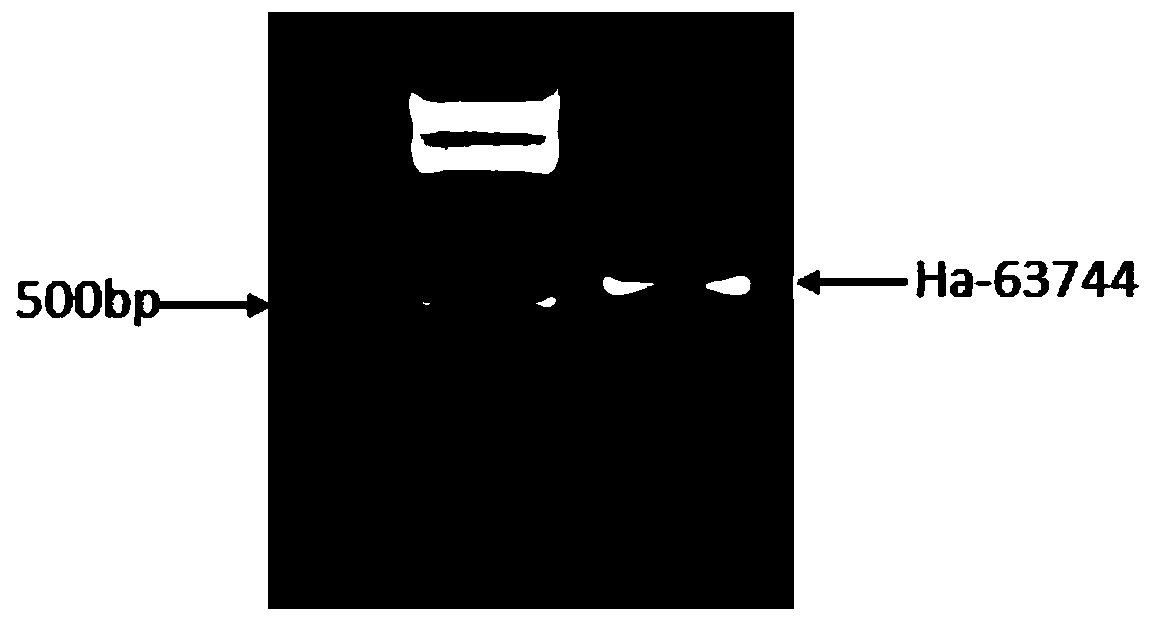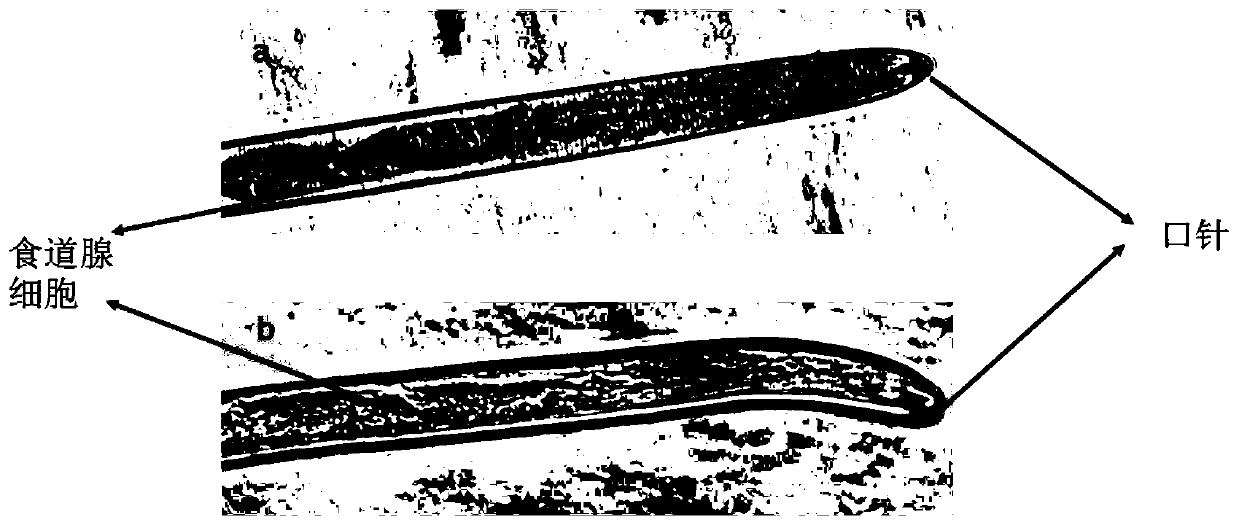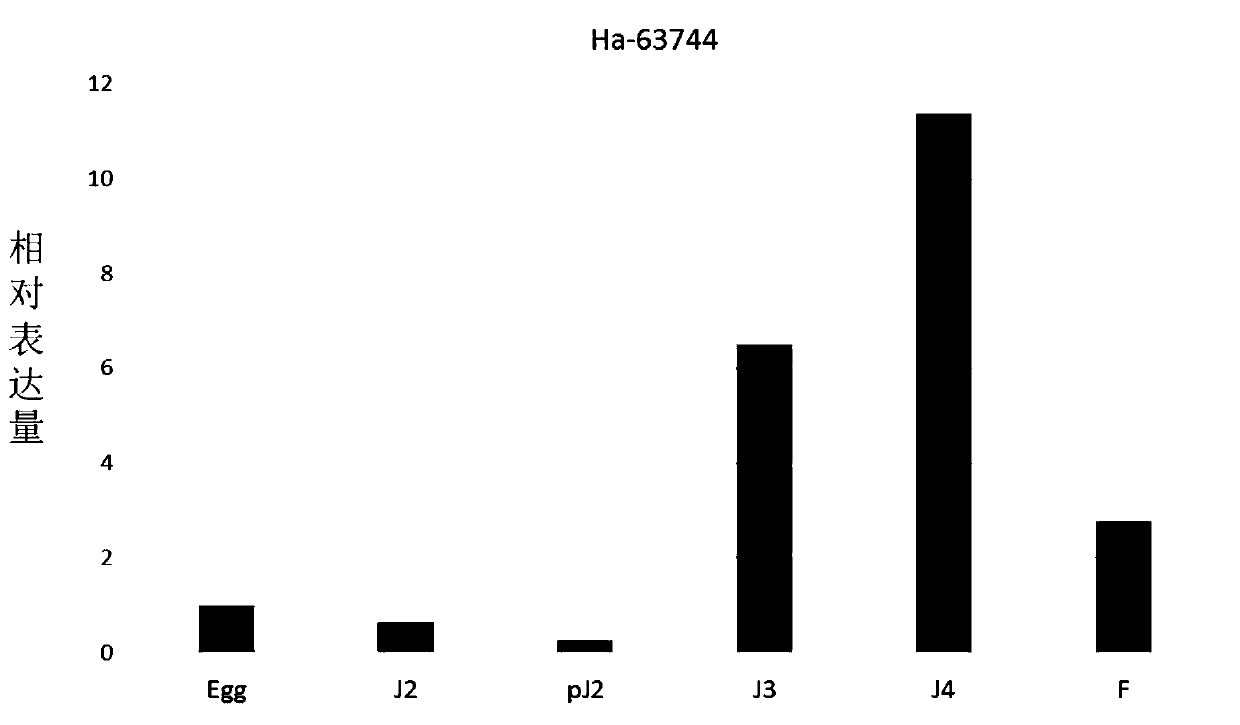Cereal cyst nematode ha-63744 protein, coding gene and its application
A technology of ha-63744, cereal cyst nematode, which is applied in the fields of application, nematicides, genetic engineering, etc., can solve the problems of lack of control methods, soil pollution, and not being economical and effective
- Summary
- Abstract
- Description
- Claims
- Application Information
AI Technical Summary
Problems solved by technology
Method used
Image
Examples
Embodiment 1
[0018] Example 1. Discovery of Ha-63744 protein and Ha-63744 gene
[0019] 1. Collect nematode larvae (about 5000 heads), wash 2-3 times with DEPC water, transfer to 1.5ml centrifuge tube, add 1ml Trizol (Invitrogen), quick freeze in liquid nitrogen for 30S, 37℃ water bath for 30S, repeat freezing and thawing 4-5 times, then let stand at room temperature for 5 minutes, extract total RNA, use DNA-free TM The DNA Removal Kit removes the remaining DNA in the total RNA, and reverse transcribes the cDNA.
[0020] 2. Using cDNA as a template, the upstream primer HaFull-F: 5'-ATGCGCGCCATCCTCTTCCT-3'; the downstream primer HaFull-R1: 5'-CTAATTTGTCGGTTCATTAATCTG-3' for PCR amplification.
[0021] Upstream primer HaFull-F: 5’-ATGCGCGCCATCCTCTTCCT-3’;
[0022] Downstream primer HaFull-R1: 5’-CTAATTTGTCGGTTCATTAATCTG-3’
[0023] The amplification system is 10×PCR Ex Buffer (Mg2+), 5μl; dNTP (10mM), 4μl; forward primer (10mM), reverse primer (10mM) each 1μl; Ex Taq, 0.5μl; cDNA first strand templa...
Embodiment 2
[0025] Example 2. In situ hybridization location analysis of Ha-63744 gene
[0026] Using the Ha-63744 gene cloning vector as a template, the target sequence was amplified by conventional PCR, and the upstream primer HaH-F: 5'-GATGCGCACAAAGGAGCAAG-3'; the downstream primer HaH-R: 5'-TCTACTGGTGCACTGCTTGG-3' was used to perform the PCR reaction. The system is as follows: 10×PCR Ex Buffer(Mg 2+ ), 2μl; dNTP (10mM), 1μl; forward primer (10mM), reverse primer (10mM) each 1μl; Ex Taq, 0.3μl; plasmid template, 1μl; deionized water, 14.2μl, total volume 20μl. The amplification program was denatured at 94°C for 5 minutes; the next 34 cycles of 94°C, 30sec, 60°C, 30sec, 72°C extension for 1 min; the last 72°C extension for 10 minutes, stored at 4°C. The PCR products were separated and purified by 1% agarose gel electrophoresis. Digoxin-labeled positive-strand probe and reverse-strand probe were synthesized by asymmetric PCR. Use HaH-F or HaH-R as primers and use the target fragment recov...
Embodiment 3
[0027] Example 3 Developmental expression analysis of Ha-63744 gene
[0028] Refer to Long et al., the method [Long H, Peng H, Huang W, Wang G, Gao B, Moens M, and Peng D. Identification and molecular characterization of a new β-1,4-endoglucanase gene (Ha-eng-1a) In the cereal cyst nematode Heteroderaavenae.European journal of plant pathology.2013,134:391-400.], the roots of Wenmai 19 susceptible wheat were inoculated with CCN second instar larvae for 5d, 10d, 20d and 30d, and then the enzyme lysis method was adopted. J2, J3, J4 and females after infection were separated, and J2 and eggs before infection were collected at the same time. Using magnetic bead method to extract mRNA of 6 ages, reverse transcribed into first-strand cDNA as template, and use primer 5 software to design Ha-63744 gene specific primer upstream primer HaQ-F: 5'-TCGCCTCAAAAGCAGTTGTC-3'; Downstream primer HaQ-R: 5'-TCTGCCAAATCGCCATTGTC-3', using Realtime PCR relative quantitative technology to detect the ex...
PUM
 Login to View More
Login to View More Abstract
Description
Claims
Application Information
 Login to View More
Login to View More - R&D
- Intellectual Property
- Life Sciences
- Materials
- Tech Scout
- Unparalleled Data Quality
- Higher Quality Content
- 60% Fewer Hallucinations
Browse by: Latest US Patents, China's latest patents, Technical Efficacy Thesaurus, Application Domain, Technology Topic, Popular Technical Reports.
© 2025 PatSnap. All rights reserved.Legal|Privacy policy|Modern Slavery Act Transparency Statement|Sitemap|About US| Contact US: help@patsnap.com



